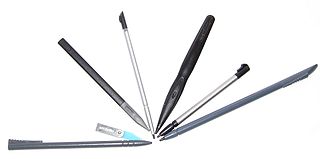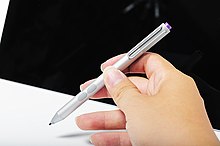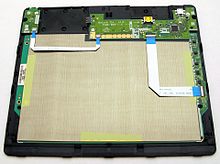
A pointing device is a human interface device that allows a user to input spatial data to a computer. CAD systems and graphical user interfaces (GUI) allow the user to control and provide data to the computer using physical gestures by moving a hand-held mouse or similar device across the surface of the physical desktop and activating switches on the mouse. Movements of the pointing device are echoed on the screen by movements of the pointer and other visual changes. Common gestures are point and click and drag and drop.

A graphics tablet is a computer input device that enables a user to hand-draw images, animations and graphics, with a special pen-like stylus, similar to the way a person draws images with a pencil and paper. These tablets may also be used to capture data or handwritten signatures. It can also be used to trace an image from a piece of paper that is taped or otherwise secured to the tablet surface. Capturing data in this way, by tracing or entering the corners of linear polylines or shapes, is called digitizing.

Handwriting recognition (HWR), also known as handwritten text recognition (HTR), is the ability of a computer to receive and interpret intelligible handwritten input from sources such as paper documents, photographs, touch-screens and other devices. The image of the written text may be sensed "off line" from a piece of paper by optical scanning or intelligent word recognition. Alternatively, the movements of the pen tip may be sensed "on line", for example by a pen-based computer screen surface, a generally easier task as there are more clues available. A handwriting recognition system handles formatting, performs correct segmentation into characters, and finds the most possible words.

A stylus is a writing utensil or a small tool for some other form of marking or shaping, for example, in pottery. It can also be a computer accessory that is used to assist in navigating or providing more precision when using touchscreens. It usually refers to a narrow elongated staff, similar to a modern ballpoint pen. Many styluses are heavily curved to be held more easily. Another widely used writing tool is the stylus used by blind users in conjunction with the slate for punching out the dots in Braille.

A touchpad or trackpad is a type of pointing device. Its largest component is a tactile sensor: an electronic device with a flat surface, that detects the motion and position of a user's fingers, and translates them to a position on a screen, to control a pointer in a graphical user interface. Touchpads are common on laptop computers, contrasted with desktop computers, where mice are more prevalent. Trackpads are sometimes used on desktops, where desk space is scarce. Because trackpads can be made small, they can be found on personal digital assistants (PDAs) and some portable media players. Wireless touchpads are also available, as detached accessories.

Mobile computing is human–computer interaction in which a computer is expected to be transported during normal usage and allow for transmission of data, which can include voice and video transmissions. Mobile computing involves mobile communication, mobile hardware, and mobile software. Communication issues include ad hoc networks and infrastructure networks as well as communication properties, protocols, data formats, and concrete technologies. Hardware includes mobile devices or device components. Mobile software deals with the characteristics and requirements of mobile applications.

An interactive whiteboard (IWB), also known as interactive board or smart board, is a large interactive display board in the form factor of a whiteboard. It can either be a standalone touchscreen computer used independently to perform tasks and operations, or a connectable apparatus used as a touchpad to control computers from a projector. They are used in a variety of settings, including classrooms at all levels of education, in corporate board rooms and work groups, in training rooms for professional sports coaching, in broadcasting studios, and others.

A tablet computer, commonly shortened to tablet, is a mobile device, typically with a mobile operating system and touchscreen display processing circuitry, and a rechargeable battery in a single, thin and flat package. Tablets, being computers, have similar capabilities, but lack some input/output (I/O) abilities that others have. Modern tablets largely resemble modern smartphones, the only differences being that tablets are relatively larger than smartphones, with screens 7 inches (18 cm) or larger, measured diagonally, and may not support access to a cellular network. Unlike laptops, tablets usually run mobile operating systems, alongside smartphones.

Pen computing refers to any computer user-interface using a pen or stylus and tablet, over input devices such as a keyboard or a mouse.
A text entry interface or text entry device is an interface that is used to enter text information in an electronic device. A commonly used device is a mechanical computer keyboard. Most laptop computers have an integrated mechanical keyboard, and desktop computers are usually operated primarily using a keyboard and mouse. Devices such as smartphones and tablets mean that interfaces such as virtual keyboards and voice recognition are becoming more popular as text entry systems.

In computing, an input device is a piece of equipment used to provide data and control signals to an information processing system, such as a computer or information appliance. Examples of input devices include keyboards, mouse, scanners, cameras, joysticks, and microphones.
Handwriting movement analysis is the study and analysis of the movements involved in handwriting and drawing. It forms an important part of graphonomics, which became established after the "International Workshop on Handwriting Movement Analysis" in 1982 in Nijmegen, The Netherlands. It would become the first of a continuing series of International Graphonomics Conferences. The first graphonomics milestone was Thomassen, Keuss, Van Galen, Grootveld (1983).

In computing, a stylus is a small pen-shaped instrument whose tip position on a computer monitor can be detected. It is used to draw, or make selections by tapping. While devices with touchscreens such as newer computers, mobile devices, game consoles, and graphics tablets can usually be operated with a fingertip, a stylus provides more accurate and controllable input. The stylus has the same function as a mouse or touchpad as a pointing device; its use is commonly called pen computing.
The history of tablet computers and the associated special operating software is an example of pen computing technology, and thus the development of tablets has deep historical roots. The first patent for a system that recognized handwritten characters by analyzing the handwriting motion was granted in 1914. The first publicly demonstrated system using a tablet and handwriting recognition instead of a keyboard for working with a modern digital computer dates to 1956.

Microsoft Tablet PC is a term coined by Microsoft for tablet computers conforming to a set of specifications announced in 2001 by Microsoft, for a pen-enabled personal computer, conforming to hardware specifications devised by Microsoft and running a licensed copy of Windows XP Tablet PC Edition operating system or a derivative thereof.
The RAND Tablet is a graphical computer input device developed by The RAND Corporation. The RAND Tablet is claimed to be the first digital graphic device marketed as being a low cost device. The creation of the tablet was performed by the Advanced Research Projects Agency. The RAND Tablet was one of the first devices to utilize a stylus as a highly practical instrument.

S Pen (Korean: S펜) is a wireless digital pen stylus designed and developed by Samsung Electronics which uses Wacom pen technology. It is made for use with supported Galaxy mobile devices like smartphones and tablets, as well as selected Samsung Notebook, Samsung Galaxy Book, and Chromebook notebooks. It was first released with the Samsung Galaxy Note in 2011, becoming the core of the Note line of products.

The Surface Pro is a first generation 2-in-1 detachable of the Microsoft Surface series, designed and manufactured by Microsoft. The device ran a 64-bit version of Windows 8 Pro operating system with a free upgrade possibility to Windows 8.1 Pro, and eventually also Windows 10. Initially announced as Surface for Windows 8 Pro on June 18, 2012, at a Los Angeles event, Microsoft later renamed the device to Surface Pro, and launched it on February 9, 2013.

An active pen is an input device that includes electronic components and allows users to write directly onto the display of a computing device such as a smartphone, tablet computer or ultrabook. The active pen marketplace has long been dominated by N-trig and Wacom, but newer firms Atmel and Synaptics also offer active pen designs.

The Surface Pen is an active stylus and digital pen developed by Microsoft for its series of Surface computing devices. It is designed to showcase the pen computing capabilities of Microsoft's Windows 8/8.1 and Windows 10 operating systems.


















